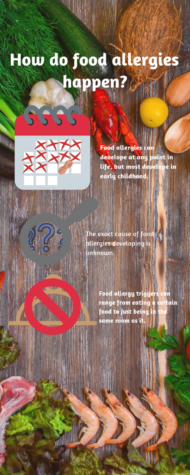A two-year-old Kaitlyn Skelton sits down with a banana and a bowl of peanut butter. As she eats most of it gets on her in the process, and her mother notices that she struggles to breathe. Skelton’s grandmother then examines her, she notices hives cover Skelton’s body.
“At that point, I started to worry that [she] was having an allergic reaction,” Christy McGraw, Skelton’s mother, said.”[She wasn’t] breathing anymore, but she had this look of panic.”
Now a sophomore, Skelton has a severe allergy to peanuts. If she comes into contact with a peanut or a peanut product, the reaction triggers and someone must administer her an EpiPen.
“I’ve had people in the past try to force peanut products in my face and chase me around with it,” Skelton said. “They think food allergies are like you don’t really like the taste of something. When to reality, it could kill them.”
An estimated 15 million people in the U.S. have food allergies, with 5.9 million of people under the age of 18. The most common food allergies are nuts, milk, eggs, soy, fish and crustacean shellfish.
“We have lots of kiddos with different kinds of food allergies and varying levels of severity,” nurse Elisa Watkins said. “Probably 75, give or take, with different food allergies.”
Senior Solomon Davis also suffers from food allergies to peanuts and tree nuts such as cashews and almonds. He first discovered his allergy after eating a peanut.

“The first time I had my first reaction, I was about 4 years old. I ate it, and at first my throat started feeling weird,” Davis said. “My eyes got really red, and I just started throwing up a lot. I went to a hospital”
Allergies can lessen in severity over time and people can eventually outgrow them, and children outgrow allergies more than adults do. Davis used to have a severe allergy to peanuts, but the severity has lessened in the last 3 years. Only about 20% of people outgrow a peanut allergy.
“My peanut allergy is the severe one, but things like tree nuts aren’t as severe,” Davis said. “I recently found out I’m not allergic to pecan anymore.”
Those with food allergies have to use caution in their environment at all times to make sure they do not get exposed to allergens. Schools usually understand food allergies, with teachers changing activities that involve foods like peanut butter if requested. Also, elementary schools have ‘peanut-free’ tables in lunchrooms
“Be aware that other people around you may be different than you, may have different needs than you,” Watkins said. “So just to be more aware of what’s going on around them and just be more self-aware”


